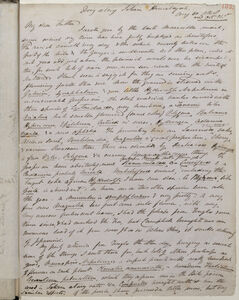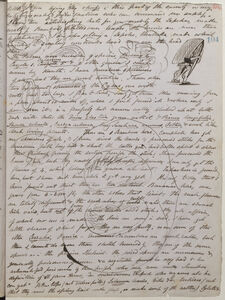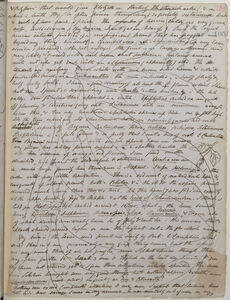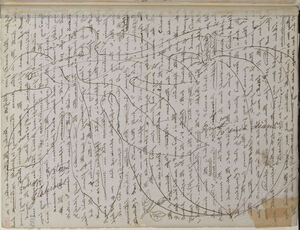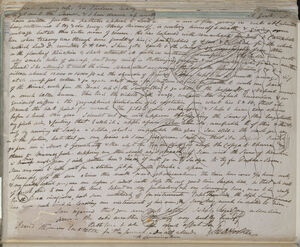It rains everyday at Darjeeling & the Ganges has flooded. Plant are flourishing, especially Galium, Synaphalium, Hydrocotyle nepalensis, Cyrtandraceae spp, Torenia like Asiatica, Polygona, Balsams, Hypericum, Epilobium, Urticeae, Hydrangea, Adamia, Cyanea, Ophelia, Bignonia resembling B. picta. Prevailing trees are Laurineae, Chestnut, Oaks, Alder, Birch, Bucklandia, Magnolia, Cherry & Rosaceous trees. Climbers incl Araliaceae, Hydrangea, Vitis, Polygona & an Amaranthaceous thing. There are no grasses or Ranunculaceae & 1 Crucifera: Cardamine hirsuta, Umbeliferae incl a Hydrocotyle, Mimulus semperflorens & a liquorice scented Magnolia. Collectors from Tonglo have got Meconopsis nepalensis, Clematis acuminata, Thalictrum sp & Aconitum palmatum: the source of 'Bik' poison used in Sikkim. Has poison for the museum & is getting Lepcha hats & umbrella [illustrated]. Has 9 palms: Phoenix, Caryota & Calamus spp & museum specimens of all, also specimens of a Cycas & all 8 local bamboos & rices, but no Tabasheer. Discusses wild & cultivated bananas & enormous cucumbers. Local people eat most things: fern tops, Solanum leaves, vitis, Urticae, Bolete, Polypore, berries & a Cucurbitaceae with large fruit that he describes & illustrates. Discusses: orchids in the region, a Streptolirion sent to Calcutta [Kolkata], Araliaceae incl. Helwingia, alpine plants compared to Bhotan & Nepal, relative altitude where plants such as figs & Rhododendrons are found. JDH has collectors in Tibet, Sikkim & the Terai where there is jungle flora & Sylhet spp. Discusses [Archibald] Campbell & Lord Dalhousie. & arrangements for trip to Kinchin [Kanchenjunga]. Wants to research the geographical distribution of plants in high mountains, or go to upper Assam tea districts via Gowahatty or across the Cossya to Churrra & Munneypore. & find place in Assam to grow Gutta Percha. Next year JDH may return to Kinchin or go to Sudya & Dupha-Bom. Asst Surveyor General Captain Thuillier has lent instruments.
Transcript
[this whole page is covered with a rough illustration of the male flower of the Cucurbitaceae described on page 4 (Hodgsonia heteroclita). Annotations label the glands, Calyx 5 cleft, tails, colum[sic] and ♂ flower nat[ural] size]
Darjeeling Sikim Himalayah
Aug 30 1848 *1
My dear Father
I wrote you by the last Marseilles mail, since which my time has been fully employed as heretofore. The rain it raineth every day, & the whole country between the foot of the hills & the Ganges is underwater as to this place, were it not 700 odd feet above the plains it would soon be swamped too, for such lots of rain was never seen nearer than the west of Scotland. Plants seem to enjoy it for they are coming out & flowering faster than ever now the ground is strewed with Galium, Gnaphalium & your little Hydrocotyle nepalensis in inconceivable profusion, the steep riverside banks covered with three species of Cyrtandraceae, very handsome, a Torenia like Asiatica but smaller flowered (same color) Polygona, Balsams, Hypericum, Epilobium, Urticeae in scores, Hydrangea, Adamia, Cyanea,& a new Ophelia. The prevailing trees are Laurineae chestnut Oaks, Alder or Birch, Bucklandia, Magnolia in great proportion, Cherry & various Rosaceous trees. These are climbed by Araliaceae, Hydrangea, a few Vitis, Polygona & a curious Amaranthaceous thing. of Grasses we have absolutely none, Ranunculaceae perhaps a Clematis not in flower yet 0 -- Crucifera 1, a Cardamine probably hirsuta. Umbeliferae several, including the largest extra African Hydrocotyle I have ever seen. A Bignonia, like picta is abundant! so have one or two other species been all the year -- a Mimulus is semperflorens & very pretty -- a very fine new Magnolia has just come into flower, with very long narrow pubescent leaves, I had the foliage from Tonglo some time since, & had marked the Tree, but Campbell brought me an enormous load of it from 1000 ft or so below this, it smells deliciously of liquorice.
My party returned from Tonglo the other day bringing as usual none of the things I sent them for, but lots of others, perhaps as good, Meconopsis Nepalensis a superb plant with really hundreds of flowers on each plant. Clematis acuminata, a handsome Thalictrum, Aconitum palmatum, which they assure me is the Bik poison used in Sikim [Sikkim] at any rate & a Compositae brought with it has the similar effects. Of the poison I have procured a little more, but very
little. There being no chiefs in this part of the country or any but miserably poor natives who can command no supply. I have two attempting hats for you, used by Lepchas, made neatly[?] of Bamboo platted over leaves, the brims are more than 4 feet across. I am also getting a Lepcha umbrella made which consists of similarly constructed hood worn over the head thus [an illustration of a person wearing a triangular hood over the upper body appears here].
My palms now number 9 species, Phoenix 4, Caryota 1. Caryota Calamus 5 & 2 other genera I can't name by Kunth. I have museum specimens of all, but they are great troubles. I have also two excellent specimens of the Cycas, one with roots but too large I fear to live, I only got them this morning from a place about 10 miles off, where I first found it & where only I have seen it: in a fearfully hot narrow valley blocked up at both ends with mts: the Ficus elastic grows with it Pinus longifolia, Shorea robusta, Careya arborea, long Sacchara, Arums, Pothos, & such like heat loving plants. There are 8 Bamboos here, Campbell has got me specimens of all, & I have dried the leaves & procured sticks for the museum, both long bits & short, the latter you had better split to shew[sic] their thickness, placing the section beside the stick: I have procured the leaves of all but they scarcely betray specific differences; I can only get the flower of 4, which belong to two genera at least. Tabasheer is found here, but I have not been able to get any yet. It is only today that I have found out that there are two distinct Bananas here, one grows from 4 -- 6500ft; the other below that limit: the male flowers are totally different & the seeds also: of wild cult[ivated]. var[ietie]s there are several hill var[ietie]s, but not of from the domesticated wild stock, they all affirm[?], of which no use is made. The Rices are now in seed, I have got little sheaves of 8 kinds for you, they are very pretty, as are some of the other Cerealie; Panica -- Enormous Cucumbers are much eaten, but these I cannot do more than sketch hurriedly, they are of the same species as in the plains I believe. the wild species are numerous & generally poisonous of course & a vegetable must be very bad to be acknowledged poisonous by these people who may come under Sambos definition of the genus Homo, "a omnivorous tripod who requires[?] all he can get" Fern tops (not roots or pith) Solanum leaves, vitis &c. Urticae (not that they raise the spring kail under glass, or make soup of the nettles) Bolete &
[large, rough illustrations appear here, they show a dissected fruit of the Cucurbitaceae described below (Hodgsonia heteroclita), annotations read "Roots always double a little one on one side", "embryo young flat"]
Polypore that would give Klotzsch or Berkely [Berkeley] the stomach ache (& on which in truth they do often poison themselves,) especially scitamineae buds & roots of some species. The number of berries eaten is very great vitis, Antidesma (the Myrica I can't get or hear of). But the most curious eatable fruit is of a magnificent plant that has puzzled me beyond any--thing -- Evidently a Cucurbitaceae (not Nhandirobaea) a very large climber I procured in the hot valleys, the fruit is as large as a human head many lobed & covered with a rich brown short pubescence contains several nuts not ripe yet each with an albuminous (apparently) seed. The Se tendrils are axillary. Flower white with rich brown solid veins[?] & white fimbriated border as in Trichosanthes. The nuts imbedded in a half fleshy & half corky pulp I have a good drawing of all but the ♀ flower which I have not seen. I found it scrambling over Markea & other beeches in the hot valleys 5000 ft below this, appended is a sketch: Epiphytial Orchideae are quite off flowering & terrestrial going out. Scitmanineae still are numerous 2000ft below this, & two very handsome Epiphytic species up here, one 4 feet high. All the trees, especially old Chestnuts & Oaks, are copiously garnished with [one word struck through] epiphytes, especially Begonia, Cyrtandeae, Ferns, Urticeae, Orchideae, Scitamineae. Streptolirion is in full flower & so pretty that I sent a box of roots to Calcutta *2. One, yellow, has solitary flowers enclosed in 2 spathed bractea, the other has raceme of orange red flowers, I can find neither described, but I want the seed vessels to determine. Araliaceae are a much larger family here than even in Nepaul [Nepal]. I refer Helwingia to this order with very little hesitation. There is a sad want of naked rock here & consequently of alpine plants, both in Bhotan [Bhutan] & in the N[orth]. W[est]. the alpine plants descend much lower than they do here. At this house (7400 ft) I am exactly at the upper limit of Figs & Pepper & at the lower of Rhododendron. I think I told you that Epiphyt[ic]. orchid ascend to 10,000, which is the lower limit here of Thalictrum, Delphinium, Meconopsis, Rosa, Ranunculus, Primula & Taxus, all of which descend considerably lower W[est]. of this, & East too. It is curious that plants should ascend higher so near the highest mt in the glo whole range.
My men in the Terai send plants up daily by post to Campbell who sends them on to me, occasionally a very good thing comes, but the plants are very much those of all hot jungles, more Silhet [Sylhet] species though than anywhere further W[est]. I sent 3 men to Thibet [Tibet] on the last day I wrote to you[,] they have not returned yet & I fear their collections will be spoiled. The men from Sikkim brought some very good things but nothing alpine except some Rhododendrons (none new) in fruit, an Iris, & Cotoneaster?
Nothing can exceed Campbell's attentions to me, now, I expect that Colvile has told him how savage I was on my arrival, he was mentally out of order on my
[a rough illustration of a leaf and fruit of the Cucurbitaceae described above [Hodgsonia heteroclita] covers this whole page, annotations read "fruit 10 inch diam" "Foliage & stem glabrous"]
first coming up, & is I believe really [part of mss missing] ly anxious to get me to the snow & I have drawn up anoth
I have only seen the sun 3 times this month, so as to get observations. The time here was 3/4 hour out, & my watch which you gave me before I went with Ross the only good time keeper here, so that all sorts of people send to me for the time. I spent one day polishing up my surveying lore, so as to be ready for the Terra incognitae, but I am wretchedly off for instruments. Capt[ain] Thuillier the Ass[istan]t. Surveyor General has been most kind in lending me instruments of his own; & I am very much indebted to him.
I am rejoiced that your arm gets better. I shall send my collections home in the cold weather: they are very bulky now.
Best love to all yr most affect[ionate] son | Jos D Hooker [signature]
I send Thomson[']s last letter for the Journal. -- Do not allude to Cunningham.
[this whole page is covered with a rough illustration of the male flower of the Cucurbitaceae described on page 4 (Hodgsonia heteroclita). Annotations label the glands, Calyx 5 cleft, tails, colum[sic] and ♂ flower nat[ural] size]
1. An annotation written in another hand records that the letter was received Oct 31st.
2. The current name of the city formerly called Calcutta is Kolkata.
Please note that work on this transcript is ongoing. Users are advised to study electronic image(s) of this document where possible.
Powered by Aetopia

